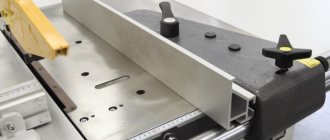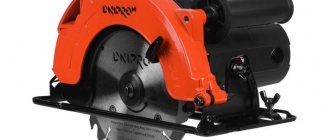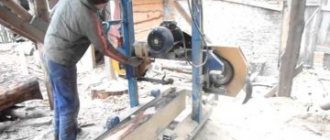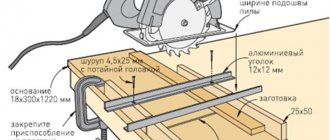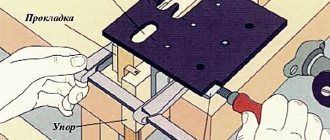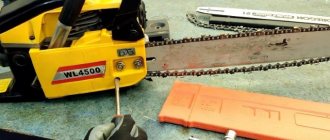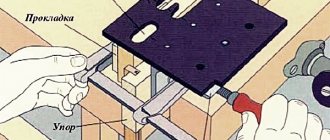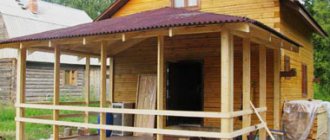In industrial and home workshops, workers use electrical appliances for different purposes. Various elements are used to process workpieces. They ensure high-quality work.
Circular
Guide bar for circular saw
Thus, the guide bar for a circular saw serves as an additional device for performing smooth, precise cuts.
Sometimes the tool manufacturer sells parts that accompany the main mechanism in a kit. If the tire is missing, it is not difficult to make it with your own hands from available material.
What role does the guide play?
The circular saw guide guides the sliding of the tool along the cutting line and prevents its deflection. The correct design of this part determines the even cut of the workpieces and the absence of defects in the processing areas.
When using a circular saw, the worker controls the movement process.
To comply with safety regulations, he must:
- securely fix the electric saw;
- secure the workpiece.
It is easier to ensure safety and quality of work using the second method. When the parts are not in the package with the saw, you can make them yourself.
Step-by-step instructions for making an aluminum guide
The only difference from the plywood bus is that aluminum U-shaped profiles are used as slats in this design. They are fixed to the plywood frame-limiter with self-tapping screws and serve to guide the saw blade lengthwise.
Aluminum U-shaped profile
Important! When using an aluminum profile, two fluoroplastic plates can be used as a limiter. It is not necessary to make a backing in the form of plywood, since aluminum itself will strengthen the structure and make it stable.
PTFE limiters
How many types of tires does a circular car have?
The circular saw guide not only serves as a safety element, it allows you to increase productivity. Devices of different designs have been developed, they are:
- bilateral;
- one-sided;
- symmetrical;
- asymmetrical.
A universal device is used to process a workpiece of non-standard shape. This guide can be used with a circular saw or a hand saw.
Tires for circular saws
Specialized tires are used when performing professional tasks.
When crossbars are cut at an angle, a textolite or plywood restriction made of bars is installed. Before installing supports, check:
- reliability of clamps;
- tire surfaces for deformation;
- for compliance of the workpiece materials with the guide.
Thrust slats are made of metal or wood. It is important that they are stable under mechanical stress. They did not change their shapes and sizes. Products are used for production from:
- profile;
- rail;
- corners;
- bars.
The structure is attached to the base:
- self-tapping screws;
- screws;
- bolts.
Ruler
There is another stubborn tool - a ruler.
It's quite simple to make from a strip of plywood. The width of the fragment is taken 20 cm more from the working area. And the base is fixed with fastening hardware. Before work you need to check with test cuts:
- tool behavior;
- vibration;
- the level of physical effort required to perform the operation.
Reliable, safe execution of actions depends on the fastenings:
- clamps;
- clamps;
- movable carriage;
- retainers.
These elements fix the workpiece in the required position. The installed limiter prevents the sharp cutting part from deviating from the perpendicular arrangement of the wood fibers.
What is a circular saw?
In everyday life and in production, a circular saw is necessary for sawing various materials (wood, slate, plasterboard, soft metal, plywood, etc.). This hand-held electric tool (as standard) is designed to perform straight cuts with a depth of 40 to 140 mm (most models produced by manufacturers allow you to make right angle cuts up to 85 mm, but there is a line of more powerful equipment for construction sites). During the operation, the operator holds the device firmly in his hands and carries out sawing, moving along the workpiece. At the same time, there are no restrictions on the size of the workpieces in terms of length and width. It is possible to cut at an angle to the surface of the part.
Circular saw device
Saw models vary in power. The most budget devices have a power of up to 1.2 kW and are designed for sawing workpieces up to 4.5 cm thick. They are excellent for household needs, carrying out periodic work for short periods of time and are simple and unpretentious. If you need to make a cut up to 6.5 cm, and this needs to be done often and for a long time, you will need a semi-professional tool with a power of up to 1.8 kW . To carry out production tasks, professional equipment with a power of up to 2.2 kW , withstanding long-term loads and capable of cutting parts up to 8.5 cm thick. In addition, tools are produced intended for use in woodworking enterprises, capable of sawing workpieces up to 14 cm thick. 1 cm. Its power reaches 5.5 kW , and weight - up to 100 kg.
A circular saw
Important! For home workshops, devices with a power of about 1 kW are usually sufficient. Before purchasing a model, it is important to take this point into account, since overpaying for the saw itself and for the electricity it consumes, as a rule, is not justified by necessity.
Choosing a modification based on the purpose
When choosing disks for a tool, you need to pay attention to their technical parameters.
- Tooth sharpening angle . Soft materials are sawed with discs that have teeth inclined in the direction of rotation of the disc. To work with metal, models with a negative sharpening angle are required.
- Number of teeth . For sawing different materials, you should select discs with different numbers of teeth: for soft ones - models with a large number of teeth, for hard ones - with a small number. For example, for wood, the minimum number of teeth is 24.
The marking of the blades includes data on its diameter and the size of the seat.
To use a circular saw for a long period of time, it is important that it does not weigh too much, is ergonomic, and has well-sharpened blades. Holding the unit in your hand for a long time is not at all easy. Operator fatigue can lead to poor sawing quality. Therefore, many craftsmen who work with saws practice placing them on a table.
Circular saws are often mounted on a table
The point of such a device is to secure the saw body under the tabletop so that only one sawing disc is above the table. The workpiece moves along the tabletop and is sawed by a rotating disk. Such a stationary device greatly facilitates work and allows continuous work without loss of quality and quickly. Manufacturers offer a large number of models of saws placed on tables. The cost of structures varies from 8 (equipped with the most primitive saws) to 140 thousand rubles. Self-manufacturing of the structure allows you not only to save money, but also to have a unit at your disposal in accordance with your own requirements.
Making a table for a circular saw is easy
Technical features of homemade devices
The factory guide for a circular saw does not solve all production problems. The manufacturer sets its dimensions, which often do not suit the master in terms of board length or other technical characteristics.
Guide production procedure
If a homemade stop is installed during work processes, take into account:
- size of the workpiece;
- saw feature;
- how often the tool is used.
Exercise control over operations:
- slice lengths;
- productivity and specifics of technology application;
- groove widths;
- according to the cutting directions;
- density of materials.
The carpenter must correctly evaluate the workpiece in terms of size and material of production.
A properly selected tire will simplify the operation with precise cuts.
Stop ruler
Independent production of devices for circular saws requires strict adherence to safety rules.
The cutting stop is often used when processing material with a circular saw; it is effective only in the case of a jigsaw; problems may arise with cutting: the tire is pressed against the workpiece with a clamp.
The bracket protrudes from the bottom and top of the machine table top. The result is a limiter on the length of the cut, but the saw motor inevitably rests against the clamp, and the cut is performed in two stages. The quality of the edge will be poor and there is a high chance of creating an unwanted step: to ensure a perfect cut, continuous movement of the cutting blade is necessary from the beginning to the end of the lumber. In factory models, the fastener is placed outside the circular saw line and does not interfere with work.
What is the use of stops
A self-made guide for a circular saw will save the craftsman from many problems when operating a complex and dangerous tool. Working with the disc is not always carried out exactly along the marked line and without chipping. Whatever the reason for the defect—lack of plumbing skills or experience in handling a saw—everyone wants a result without damaged materials. Arguments proving the benefits of homemade devices:
- It happens that it is enough to attach the plates with clamps, but not always. The saw will hit the clamps.
- If you need to make a single cut, you can apply a painting rule, but you will have to constantly check it to adjust the position.
- A branded guide is used to accurately set the direction along the cutting line; after aligning the strips, the operation begins immediately. High-quality tires have adhesive tape that protects them from chipping. But factory tires are made to limited sizes.
Guide
The name of the guide indicates its purpose - to move the saw smoothly to a given position.
Regardless of what materials the production will be from:
- channel;
- rectangular pipe;
- laminate - it is necessary to create a geometrically correct structure.
Pressed and wooden stops have a significant drawback:
- absorb moisture;
- swell;
- lose their shape.
If they place a loose stop, they create uncomfortable conditions with simultaneous cutting and control of the position of the rail. You need to monitor the force of pressing on the rule so as not to spoil the base.
Useful tricks and tips
There are such small devices that it is shameful to even consider them a tool. At the same time, they are great for cutting. These are the tricks of experienced masters.
Blank template
When cutting a large number of identical parts, you can use the first of them as a template for cutting subsequent copies. You just need to fasten a thrust piece on one side of the first sample with a width corresponding to the distance from the edge of the slab to the cutting disc. By installing such a template on the material to be cut, you can make many identical parts without markings.
Installation bars
The simplest part that makes it easier to install any stop and guide along the markings is a small cross-section block. There are cuts on it, the distance between which is equal to the segment from the end of the saw sole to the saw blade. Two such bars will help you install any guides quickly and accurately at the required distance from the marking line. All that remains is to secure the guide.
Pull-out protection
The protection can be any block whose width corresponds to the thickness of the workpiece being cut. If it is secured at the point where the saw blade exits the material being processed, it will act as a limiter and serve as protection against tearing out and chipping.
These devices are not limited to the range of useful homemade products that make working with a hand-held circular saw easier. These are the easiest to make. Others require time and skill. But craftsmen even make such a device as a protractor for a circular saw with their own hands. There would be a desire.
Preparatory activities
To work, you will need a tool kit with components for assembling and cutting a persistent product. You need to prepare:
- wood blanks for processing;
- solid wood from blocks, dense plywood, laminate boards;
- fasteners made of screws, self-tapping screws;
- electrical appliances – circular saw, jigsaw, drill, screwdriver;
- clamps.
If production is carried out in a home carpentry workshop, there should be a primitive furnishings of a table, cabinets, and electricity.
Instructions for production
Different materials for the production of guides require the same attitude. When laminate is being created:
- cut off 2 parts according to the size marks;
- mill the edge;
- fixed to the base with a self-tapping screw;
- Use a sheet of paper to measure the groove in width and screw it to the device;
- A tire is attached to the sole of the saw; it will serve as a side support;
- the guide is extended to the maximum so that the sole steps on it;
- saw off the laminate according to the edge markings.
The circular saw can be equipped with an external carriage
DIY guide
Such a device is not difficult to create, but it absorbs the depth of the cut.
Limiters are also made from the painting rule. A design with grooves and handles is suitable for this:
- The handles are removed from the construction model to install spring clamps in these places; after removing them, the clamp is fixed on the rule;
- propylene is used for adapters, parts are cut out in a special shape to be inserted into the grooves of the handles;
- Hollow recesses are cut out at the base of the adapter for screwing in screws;
- Place the stop on the surface and secure it firmly with a fastening element.
Fixation is carried out to the sheet with grooves located below, so as not to create obstacles for the saw to slide; only the size of the rule can limit the work.
The production of a rail miter box will allow you to cut:
- boards;
- bars;
- small workpieces.
You need to prepare:
- metal corner;
- board or plywood base;
- hardware.
Make markings along the length of the tire with places of fixation. For sizes you need to provide the following conditions:
- free movement of the board under the tire;
- not high arrangement of saw blades.
The structure is secured with bolts with parallel angles so that the sole of the circular can slide freely. This is achieved by gluing fluoroplastic strips, which reduce friction and reduce the force acting on the saw.
Create a device from a finished aluminum profile
Metal lasts much longer than wooden products. In addition, it holds steadily without distortion. For installation you will need:
- profile fragment;
- fasteners;
- plywood sheet.
Additional tools you will need to prepare:
- electric drills, metal drills;
- wrench;
- measuring items.
During production:
- take 2 profiles;
- Aluminum is attached to the plywood on both sides; chipboard is used for rigidity;
- the excess is cut off.
When combining all the work carried out, the following settings are carried out:
- a profile with a smaller cross-section is installed in the rail, the height of which should not absorb the main profile;
- fix the structure with wing screws to the sole of the circular saw parallel to the disk circle;
- the saw should be on top of the guide;
- The edges of the tire are directed to the marking line and secured.
Such limiters ensure smooth sliding of the cutting device and make it easy to operate the saw.
The simplest device can be made from plywood
For proper production, you need to make markings and strictly follow the dimensions without deviations. For this:
- measure the gap between the inner edge of the saw and the guide groove in the longitudinal cut; it is located on the supporting base of the mechanism;
- cut the plywood strip to a width less than the measured distance with the fibers on the material arranged in the longitudinal direction;
- use self-tapping screws to secure the resulting segment to the base, aligning the ends to form the working edge of the guide;
- take a caliper to determine the width in the longitudinal section; the remaining strip should fit here, parallel to the first plate, ensuring a gap between the 2 sheets.
A soft cloth is glued onto the finished tires to protect the working material from damage.
Making your own guide from plywood is the most popular option.
For a craftsman who constantly performs work on sawing wood, for example, for a furniture maker, the constant use of a tire is strictly necessary. The quality and speed of production depends on this. Experienced users and craftsmen rarely use factory-made products for cutting; more often they make them themselves.
The prerequisites for making a tire yourself are:
- Desire to save money.
- The need to introduce additions to the design that allow more efficient and multifunctional wood processing.
Necessary materials
To produce a tire from wood you will need the following materials:
- Plywood blanks with a thickness of at least 10 millimeters, the length is chosen arbitrarily according to the length of the future cut, the recommended length is 1.2 meters;
- Wooden blocks 30 x 30 mm.
- Metal strips 3-4 mm high, 8-12 mm wide, the length should be equal to the length of the sole on the circular - 2 pcs.
- Fastening elements – hardware, self-tapping screws.
- Fraser.
- Jigsaw.
- Drill with a drill bit with a diameter of 10 mm.
- Screwdriver with a bit for self-tapping screws.
- Clamps.
Step-by-step instructions for making a plywood guide
It is very important to be careful in manufacturing and adhere to dimensions, since any inaccuracy or violation of the straightness of the structure will lead to a serious deterioration in the final result, and consequently to a deterioration in the quality of the cut.
Step-by-step instruction:
- We transfer the size of the saw to the plywood and mark it.
- In order for everything to turn out smooth and beautiful, you need to use something hard and smooth; a piece of profile pipe, a square, or a guide for gypsum boards is suitable for this purpose. We fasten it with clamps at the received mark.
- We retreat 5 cm and make a cut with a router. The height and width of the cut should be the same as those of previously prepared metal plates.
- We retreat another 5 cm, mark and make another cut with a router. To obtain a straight line, we also set the metal profile as a stop.
- We attach the metal guides to the circular saw. The main thing is to do it very smoothly. The protruding parts, beyond the edges of the sole, should be sawed off. It is recommended to grind and polish the working surface, this will make it slide better. And lubricate the grooves in the plywood with wax, this will also give better glide.
- We attach wooden blocks along the edges with glue, and then also tighten them with self-tapping screws.
- For better gliding, cover the working surface of the tire with metal tape. It is very resistant to abrasion.
- That's all, the parallel stop is ready for work.
Another popular material with which you can quickly and easily make a guide for a circular saw is laminate. To do this, we suggest watching a video, the author of which tells and shows in a few minutes how to make a parallel stop from 2 laminate boards in detail, it is very interesting and useful. We recommend.
Adjusting a homemade device
Before starting work, it is necessary to make an adjustment, which consists of selecting the cutting location, as well as the depth of the cut and its length.
There are several useful tips during the adjustment process:
- The device must be positioned evenly in relation to the edges of the material. Distortions are not allowed. To check the straightness of the disk, it is lowered into the cut of the guide.
- After adjusting the tire and disk for straightness, the entire structure is secured with clamps. In some cases, it can be secured to hardware, for which special holes are made in the corners of the tire.
The tire allows you to make cuts at 45 degrees and chamfer edges, but to do this you need to adjust the angle of the circular saw blade.
Work and safety precautions
Since the circular saw itself is considered a very dangerous tool, the improper use of which can lead to serious injury, it is necessary to follow the following safety recommendations:
- When working, you must use PPE - goggles and gloves. It is also prohibited to start working with hanging items of clothing, for example, with unbuttoned sleeves.
- The circular saw starts only after the blade is placed in the guide, but without touching the surface to be processed.
- The tire must be firmly fixed with clamps, since otherwise the kinetic energy of rotation of the saw blade will be transferred to the tire, and it will “fly out”.
- All cuts must be done away from you, and the master himself must stand somewhat to the side, and not in front of the saw.
Operation of plywood tire
In addition to the guide, preparation of the saw for work is required. You need to saw off durable material with dimensions:
- height exceeding the depth of the groove;
- equal in width;
- longer than the sole.
Fastening is carried out with the restriction protruding from under the edges of the sole. To carry out the work, you need to take 2 clamps with two flat bars, but larger in thickness than the part prepared for processing. The ends of the tire are installed on the limiter so that they protrude beyond the tabletop. In areas of contact with wooden blocks, the guide is attached to the base of the table.
On the workpiece to be cut, markings are made along the cutting line. It is placed under the guide, the cutting direction and the working edge are aligned. A circular saw with a fixed limit strip is placed on the guide in such a position that the stop on the sole is aligned with the prepared gap. They saw the part, slightly guiding the part, and at the same time press the tool.
The design has proven in practice the high stability of a high-quality cut. For production, a metal I-beam is taken, which is attached to the lower plane of the workbench. The platform moves along the surface on bearings with the lower edges curved into a profile. The outrigger carriage slides freely thanks to bearings, which, due to tight pressing, relieve the structure from lateral play. The extension guide is held by the sole of the cutting tool.
Parallel angles and pipes are used to make a tire. When the sole moves, the cut is adjusted to size. Thanks to the support platform, which fits tightly to the workpiece, the stability of the cutting depth is not compromised.
The manufacturer of circular saw bars must take into account the working conditions, where the rules of use must comply with:
- the mode of use of the saw - the more often the tool is used, the stronger the raw materials for making the guide should be;
- processing parameters - you need to make sure that the disk completely cuts the thickness of the workpiece;
- technical capabilities of the mechanism.
In addition to the guide, quality cutting is affected by:
- condition of the saw and discs;
- position of the support platform.
Blunt disc teeth leave chips on the material. Tires significantly expand the functions of a circular saw, but poor care of the tool nullifies all the capabilities provided by the manufacturer.
Summary
Article Name
Guide bar for circular saw
Description
DIY guide bar for a circular saw
Author
Sarychev Alexander Viktorovich - forensic construction and technical expert, candidate of technical sciences
Publisher Name
Wikipedia of construction tools
Publisher Logo
- Related Posts
- Rating of hand-held circular saws 2021
- Reciprocating Saw Rating
- Rating of sawing machines
« Previous entry
DIY materials
The circular table consists of two main parts: a support (bed, frame), and a tabletop. The tabletop is a more important detail; the choice of material for it is taken especially carefully. Sheet material with great strength is suitable: thick plywood, particle board, textolite, aluminum sheet, steel.
Craftsmen make a table platform of the required size by connecting narrow wooden blanks together.
Suitable for the frame are wooden blocks, preferably made of hardwood material, aluminum, rolled steel: angle, channel, square and rectangular pipes. Steel products are more common and cheaper than aluminum.
- Wooden blocks for the frame are thicker: from 8x8 cm; connected to each other in various ways.
- Connection using grooves and tenons is the most labor-intensive, but it looks great and indicates a highly qualified craftsman.
- A simpler way is to connect using bolts and nuts. Metal corners are used to increase strength.
- Connection with nails is the most primitive, but fragile and short-lived.
The steel parts of the base are connected in two ways: bolts and nuts, or welding. A welded connection is used more often: it is easier and faster to make. At the beginning of welding work, it is important to control the values of right angles and the distance between parts, since during the welding process the metal heats up and deforms.
